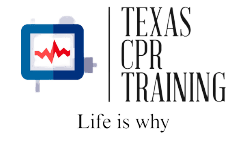214-770-6872
TexasCPRTrainingCenter@gmail.com
3301 S Country Club Rd, Garland, TX 75043
Course Outline
BLS – Basic Life Support (healthcare providers) Course Outline
- Chain of Survival
- BLS for Adults
- BLS Sequence
- Compressions
- Breathing (Using a pocket mask and BVM – Bag Valve Mask)
- Adult 2-Rescuer
- AED (Automated External Defibrillator)
- Team Dynamics
- BLS for Children
- BLS Sequence
- Compressions
- Breathing (Using a pocket mask and BVM – Bag Valve Mask)
- Child 2-Rescuer
- AED (Automated External Defibrillator)
- BLS for Infants
- Compressions
- Breaths (Using a BVM – Bag Valve Mask)
- Infant 2-Rescuer
- Automated External Defibrillator for Infants and children less than 8 years of age
- CPR with an Advanced Airway
- Rescue Breaths
- Mouth-to-Mouth Breathing
- Opioid-Associated Life-Threatening Emergencies
- Choking for all ages
Heartsaver CPR/AED (non-healthcare providers)
- Scene Safety and Assessment
- Chest Compressions
- Giving Breaths (Mouth-to-Mouth)
- Giving Breaths (With a Mask)
- Use an AED
- Putting It All Together
- Help From Others
- Adult CPR AED Summary
- Naloxone
- Adult Choking
- Course Conclusion
- Scene Safety and Assessment
- Chest Compressions
- Giving Breaths (Mouth-to-Mouth)
- Giving Breaths (With a Mask)
- Use an AED
- Putting It All Together
- Help From Others
- Child CPR AED Summary
- Child Choking
- Course Conclusion
- Scene Safety and Assessment
- Chest Compressions
- Giving Breaths (Mouth-To-Mouth)
- Giving Breaths (With A Mask)
- Putting It All Together
- Infant CPR Summary
- Infant Choking
- Course Conclusion
Heartsaver Adult First Aid Course Outline
Duties, Roles, and Responsibilities of First Aid Rescuers
- Your Role in the EMS System
- Deciding to Provide First Aid
- Asking to Give First Aid
- Maintaining the First Aid Kit
- Good Samaritan Laws
- Key Steps of First Aid
- Questions for Assessing the Scene
- When to Phone for Help
- How to Phone for Help
- Who Should Phone for Help
- Follow The Dispatcher’s Instructions
- Personal Protective Equipment
- Actions for Universal Precautions
- Actions for Exposure to Blood
- Actions for Removing Protective Gloves
- Good Hygiene and Washing Hands
- Actions for Finding the Problem
- Moving and Ill or Injured Person
- Protecting the Persons Privacy
Medical Emergencies
- Breathing Problems
- Actions for Assembling and Using Inhalers
- Actions for Helping Someone With Breathing Problems
- The Choking Sign
- How to Help Someone With a Severe Airway Block
- How to Help a Choking Pregnant Woman or Large Adult or Child
- How to Help When a choking Person Becomes Unresponsive
- Allergic Reactions
- Mild vs Severe Allergic Reaction
- How to Use an Epinephrine Pen
- Difference Between Heart Attack and Cardiac Arrest
- Fainting
- Diabetes and Low Blood Sugar
- Stroke
- Seizure
Injury Emergencies
- Bleeding
- Tourniquets
- Wounds
- Nosebleeds
- Tooth Injury
- Eye Injury
- Penetrating or Puncturing Injury
- Amputation
- Internal Bleeding
- Head, Neck and Spinal Injuries
- Broken Bones and Sprains
- Actions to Apply a Splint
- Burns and Electrical Injuries
Environmental Emergencies
- Bites and Stings
- Snake Bites
- Bee Stings
- Spider and Scorpion
- Heat Related Emergencies
- Heat Cramps
- Heat Exhaustion
- Heat Stroke
- Cold Related Emergencies
- Frostbite
- Hypothermia
- Poison Emergencies
Heartsaver Pediatric First Aid Course Outline
- Duties, Roles, and Responsibilities of the First Aid Rescuer
- Your Role as a First Aid Rescuer
- First Aid Action Plans
- Confidentiality
- Good Samaritan Laws
- 4 Key Steps of Pediatric First Aid
- Phoning for Help
- Universal Precautions
- Exposure to Blood or Other Body Fluids
- Removing Gloves
- Washing Hands
- How Children Act When Something is Wrong
- Interacting With an Ill or Injured Child
- Know When to Phone 911
- Finding the Problem
- What to Do If You Suspect Child Abuse
Illnesses and Injuries
- External Bleeding
- Dressing vs Bandage
- When to Call 911
- Bleeding Control
- Use a Tourniquet
- Shock
- Internal Bleeding
- Burns and Electrical Injuries
- Allergic Reactions
- Using an Epinephrine Pen
- Asthma
- Steps to Assemble and Use an Inhaler
- Dehydration
- Diabetes and Low Blood Sugar
- Heat Related Emergencies
- Heat Cramps
- Heat Exhaustion
- Heat Stroke
- Cold Related Emergencies
- Frostbite
- Drowning
- Amputations
- Bites and Stings
- Snakebites
- Bee Stings, Insect, and Spider Bites
- Tick Bites
- Marine Bites and Stings
- Broke Bones, Sprains, and Bruises
- Splinting
- Eye Injuries
- Nose Bleeds
- Fainting
- Fever
- Head, Neck, and Spinal Injuries
- Concussion
- Penetrating and Puncturing Injuries
- Poison Emergencies
- Seizure
- Mouth and Cheek Injuries
- Tooth Injuries
- Splinting
CPR Training in Dallas, Texas and all surrounding areas
Greenville, Texas – Irving, Texas – Addison, Texas – Farmers Branch, Texas – Duncanville, Texas – Lancaster, Texas – Sunnyvale, Texas – Coppell, Texas – Carrollton, Texas – Grand Prairie, Texas – Lewisville, Texas – Richardson, Texas – Sachse, Texas – Dallas, Texas – Seagoville, Texas – Terrell, Texas – Wylie, Texas – Denton, Texas – Fort Worth, Texas – Arlington, Texas – Plano, Texas – Frisco, Texas – Allen, Texas – Rowlett, Texas – Rockwall, Texas – Mesquite, Texas – Dallas, Texas
